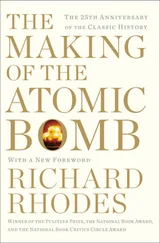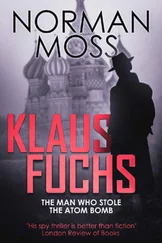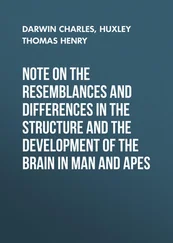J. Dyson - Documentation and Diagrams of the Atomic Bomb
Здесь есть возможность читать онлайн «J. Dyson - Documentation and Diagrams of the Atomic Bomb» весь текст электронной книги совершенно бесплатно (целиком полную версию без сокращений). В некоторых случаях можно слушать аудио, скачать через торрент в формате fb2 и присутствует краткое содержание. Жанр: Сделай сам, на английском языке. Описание произведения, (предисловие) а так же отзывы посетителей доступны на портале библиотеки ЛибКат.
- Название:Documentation and Diagrams of the Atomic Bomb
- Автор:
- Жанр:
- Год:неизвестен
- ISBN:нет данных
- Рейтинг книги:3 / 5. Голосов: 1
-
Избранное:Добавить в избранное
- Отзывы:
-
Ваша оценка:
- 60
- 1
- 2
- 3
- 4
- 5
Documentation and Diagrams of the Atomic Bomb: краткое содержание, описание и аннотация
Предлагаем к чтению аннотацию, описание, краткое содержание или предисловие (зависит от того, что написал сам автор книги «Documentation and Diagrams of the Atomic Bomb»). Если вы не нашли необходимую информацию о книге — напишите в комментариях, мы постараемся отыскать её.
Documentation and Diagrams of the Atomic Bomb — читать онлайн бесплатно полную книгу (весь текст) целиком
Ниже представлен текст книги, разбитый по страницам. Система сохранения места последней прочитанной страницы, позволяет с удобством читать онлайн бесплатно книгу «Documentation and Diagrams of the Atomic Bomb», без необходимости каждый раз заново искать на чём Вы остановились. Поставьте закладку, и сможете в любой момент перейти на страницу, на которой закончили чтение.
Интервал:
Закладка:

2. Nagasaki
On August 9th 1945, Nagasaki fell to the same treatment as Hiroshima. Only this time, a Plutonium bomb nicknamed «Fat Man» was dropped on the city. Even though the «Fat Man» missed by over a mile and a half, it still leveled nearly half the city. Nagasaki's population dropped in one split-second from 422,000 to 383,000. 39,000 were killed, over 25,000 were injured. That blast was less than 10 kilotons as well. Estimates from physicists who have studied each atomic explosion state that the bombs that were used had utilized only 1/10th of 1 percent of their respective explosive capabilities.
3. Byproducts of atomic detonations
While the mere explosion from an atomic bomb is deadly enough, its destructive ability doesn't stop there. Atomic fallout creates another hazard as well. The rain that follows any atomic detonation is laden with radioactive particles. Many survivors of the Hiroshima and Nagasaki blasts succumbed to radiation poisoning due to this occurance.
The atomic detonation also has the hidden lethal surprise of affecting the future generations of those who live through it. Leukemia is among the greatest of afflictions that are passed on to the offspring of survivors.
While the main purpose behind the atomic bomb is obvious, there are many by-products that have been brought into consideration in the use of all weapons atomic. With one small atomic bomb, a massive area's communications, travel and machinery will grind to a dead halt due to the EMP (Electro-Magnetic Pulse) that is radiated from a high-altitude atomic detonation. These high-level detonations are hardly lethal, yet they deliver a serious enough EMP to scramble any and all things electronic ranging from copper wires all the way up to a computer's CPU within a 50 mile radius.
At one time, during the early days of The Atomic Age, it was a popular notion that one day atomic bombs would one day be used in mining operations and perhaps aid in the construction of another Panama Canal. Needless to say, it never came about. Instead, the military applications of atomic destruction increased. Atomic tests off of the Bikini Atoll and several other sites were common up until the Nuclear Test Ban Treaty was introduced. Photos of nuclear test sites here in the United States can be obtained through the Freedom of Information Act.
4. Breakdown of the Atomic Bomb's Blast Zones

Diagram Outline
[1] Vaporization Point
------------------
Everything is vaporized by the atomic blast. 98% fatalities.
Overpress=25 psi. Wind velocity=320 mph.
[2] Total Destruction
-----------------
All structures above ground are destroyed. 90% fatalities.
Overpress=17 psi. Wind velocity=290 mph.
[3] Severe Blast Damage
-------------------
Factories and other large-scale building collapse. Severe damage
to highway bridges. Rivers sometimes flow countercurrent.
65% fatalities, 30% injured.
Overpress=9 psi. Wind velocity=260 mph.
[4] Severe Heat Damage
------------------
Everything flammable burns. People in the area suffocate due to
the fact that most available oxygen is consumed by the fires.
50% fatalities, 45% injured.
Overpress=6 psi. Wind velocity=140 mph.
[5] Severe Fire & Wind Damage
-------------------------
Residency structures are severely damaged. People are blown
around. 2nd and 3rd-degree burns suffered by most survivors.
15% dead. 50% injured.
Overpress=3 psi. Wind velocity=98 mph.
Blast Zone Radii
[3 different bomb types]
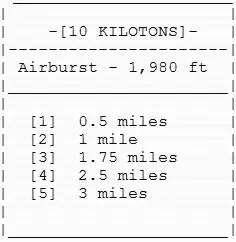
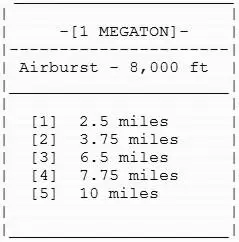
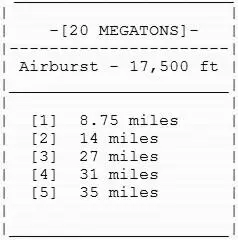
II. Nuclear Fission/Nuclear Fusion
There are two types of atomic explosions that can be facilitated by U-235: fission and fusion. Fission, simply put, is a nuclear reaction in which an atomic nucleus splits into fragments, usually two fragments of comparable mass, with the evolution of approximately 100 million to several hundred million volts of energy. [See comment.] This energy is expelled explosively and violently in the atomic bomb. A fusion reaction is invariably started with a fission reaction, but unlike the fission reaction, the fusion (Hydrogen) bomb derives its power from the fusing of nuclei of various hydrogen isotopes in the formation of helium nuclei. Being that the bomb in this section is strictly atomic, the other aspects of the Hydrogen Bomb will be set aside for now.
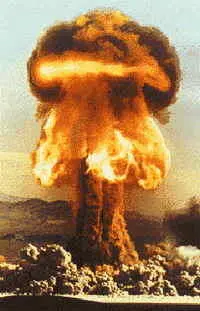
The massive power behind the reaction in an atomic bomb arises from the forces that hold the atom together. These forces are akin to, but not quite the same as, magnetism.
Atoms are comprised of three sub-atomic particles. Protons and neutrons cluster together to form the nucleus (central mass) of the atom while the electrons orbit the nucleus much like planets around a sun. It is these particles that determine the stability of the atom.
Most natural elements have very stable atoms which are impossible to split except by bombardment by particle accelerators. For all practical purposes, the one true element whose atoms can be split comparatively easily is the metal Uranium. Uranium's atoms are unusually large, henceforth, it is hard for them to hold together firmly. This makes Uranium-235 an exceptional candidate for nuclear fission.
Uranium is a heavy metal, heavier than gold, and not only does it have the largest atoms of any natural element, the atoms that comprise Uranium have far more neutrons than protons. This does not enhance their capacity to split, but it does have an important bearing on their capacity to facilitate an explosion.
There are two isotopes of Uranium. Natural Uranium consists mostly of isotope U-238, which has 92 protons and 146 neutrons (92+146=238). Mixed with this isotope, one will find a 0.6% accumulation of U-235, which has only 143 neutrons. This isotope, unlike U-238, has atoms that can be split, thus it is termed «fissionable» and useful in making atomic bombs. Being that U-238 is neutron-heavy, it reflects neutrons, rather than absorbing them like its brother isotope, U-235. [See comment.]
U-238 serves no function in an atomic reaction, but its properties provide an excellent shield for the U-235 in a constructed bomb as a neutron reflector. This helps prevent an accidental chain reaction between the larger U-235 mass and its 'bullet' counterpart within the bomb. Also note that while U-238 cannot facilitate a chain-reaction, it can be neutron-saturated to produce Plutonium (Pu-239). Plutonium is fissionable and can be used in place of Uranium-235 {albeit, with a different model of detonator} in an atomic bomb.
Both isotopes of Uranium are naturally radioactive. Their bulky atoms disintegrate over a period of time. Given enough time (over 100,000 years or more) Uranium will eventually lose so many particles that it will turn into the metal Lead. However, the process of decay can be accelerated in what is known as a chain reaction. Instead of disintegrating slowly, the atoms are forcibly split by neutrons forcing their way into the nuclei. A U-235 atom is so unstable that a blow from a single neutron is enough to split it and henceforth bring on a chain reaction (by releasing further neutrons). This can happen even when a (comparatively small) critical mass is present. When this chain reaction occurs, the Uranium atom splits into two smaller atoms of different elements, such as Barium and Krypton.
Читать дальшеИнтервал:
Закладка:
Похожие книги на «Documentation and Diagrams of the Atomic Bomb»
Представляем Вашему вниманию похожие книги на «Documentation and Diagrams of the Atomic Bomb» списком для выбора. Мы отобрали схожую по названию и смыслу литературу в надежде предоставить читателям больше вариантов отыскать новые, интересные, ещё непрочитанные произведения.
Обсуждение, отзывы о книге «Documentation and Diagrams of the Atomic Bomb» и просто собственные мнения читателей. Оставьте ваши комментарии, напишите, что Вы думаете о произведении, его смысле или главных героях. Укажите что конкретно понравилось, а что нет, и почему Вы так считаете.

